Collection! Composite current collector industry research report
2024-08-26 17:17
The function of the current collector is to carry the active material. During the charging and discharging process, the current generated by the current collector is collected and output or the current is input to the active material as a medium to realize the conversion of chemical energy and electrical energy.
Overview of 1. Composite Current Collector
Performance and advantages of (I) composite current collector
1. The current collector is the conductor of the current in the lithium battery.
The function of the current collector is to carry the active material. During the charging and discharging process, the current generated by the current collector is collected and output or the current is input to the active material as a medium to realize the conversion of chemical energy and electrical energy. The ideal current collector needs to meet the conditions of high conductivity, high stability, strong binding force, low cost, flexibility and thinness. The battery current collector is mainly made of metal foil. Due to the advantages of high conductivity and cycle stability of rolled aluminum foil and electrolytic copper foil, lithium batteries are usually used as positive and negative materials respectively.
2, lithium battery current collector facing the need to improve battery energy density, safety and cost reduction upgrade.
With the promotion of my country's energy strategy, the demand for new energy vehicles and other industries has expanded, and the performance of the catalytic lithium current collector has been upgraded, which requires further improvement of the energy density of the battery, while ensuring its safety and reducing costs. In the traditional current collector, the purity of metal copper and aluminum reached 99.5, of which copper foil accounted for about 13% of the total weight of lithium batteries, which is the key material affecting the quality of the battery energy density, while accounting for about 9% of the total cost of lithium batteries, is one of the key materials affecting the cost of batteries.
Reduce the proportion of metal foil, the foil is very thin upgrade, composite collector provides a solution. The use of lighter polymer materials to replace the traditional metal current collector, so as to achieve the effect of improving battery performance and reducing cost.
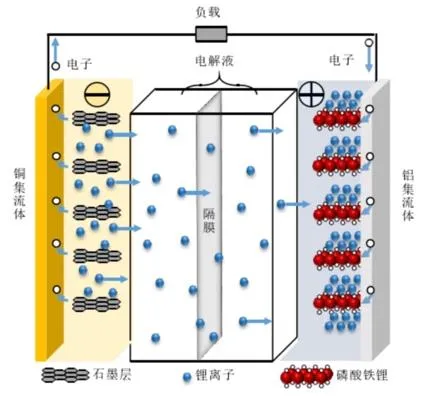
Figure: The current collector as a medium to realize the conversion of chemical energy and electrical energy
Data source: Yuaneng Technology official website
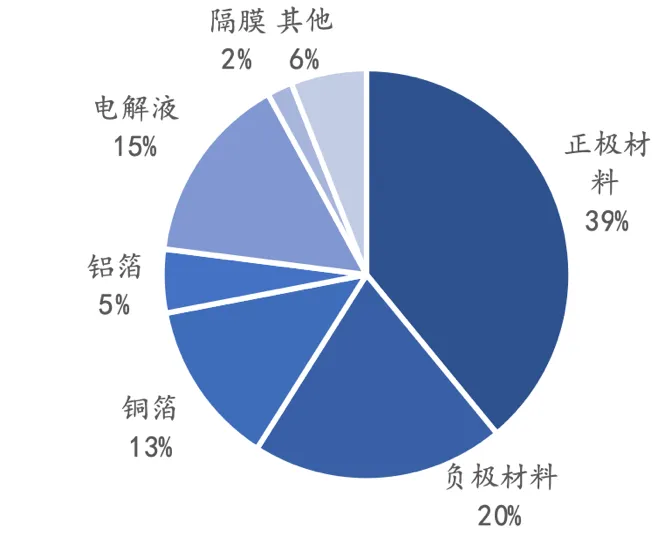
Copper Foil Occupies 13% of Lithium Battery Mass
Data source: "China's lithium-electric copper foil industry in-depth research and development prospects analysis report (2022-2029)
3. The composite current collector is a sandwich structure
The composite current collector is a sandwich structure of "metal conductive layer-PET/PP polymer material support layer-metal conductive layer". The polymer insulating resin PET/PP and other materials are used as the "sandwich" layer, and metal aluminum or metal copper is deposited on the upper and lower sides. At present, the composite aluminum foil has been realized in batch production, and the industrialization of composite copper foil is imminent.
From the structural point of view, in the mainstream products, the intermediate base film of the composite copper foil is PET/PP, the thickness is 4.5μm and 2.5 μm, the thickness of the double-sided copper plating layer is 1μm, and the total thickness is 6.5μm or 4.5 μm. The composite aluminum foil uses PET material as the base film. Taking Jinmei composite MA as an example, the product thickness is 8μm, of which the substrate PET is about 6μm. By using polymer materials with low density, light weight and low cost to replace part of the metal materials in the current collector, the energy density and safety of the lithium battery can be effectively improved and the cost can be reduced.
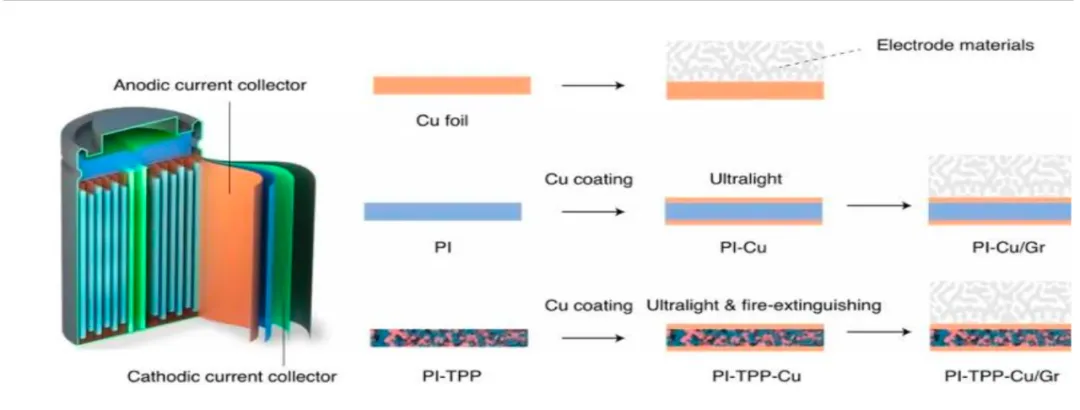
Figure: Composite current collector in a sandwich structure

Structure of PET Copper Foil
Source: Chongqing Jinmei EIA Report
Various types of substrates for (II) composite copper foil
As the non-metallic base material of the composite copper foil, a polymer material such as polyethylene terephthalate (PET), polyvinyl chloride (PVC), polyimide (PI), or polypropylene (PP) can be used. At present, PET and PP materials are mainly used as substrates in the industry. Compared with metal materials such as copper and aluminum, polymer substrates have the advantages of high flexibility, low density, and flame retardancy, which can improve the safety of lithium-ion batteries and increase energy density. However, the bonding force between the polymer substrate and the metal plating layer is poor, so that the metal plating layer is easily detached from the surface of the substrate, which may affect the long-term stability of the copper foil in the battery.
1. PET is one of the main choices for composite copper foil substrates at this stage.
Composite copper foil has certain requirements for bending, transparency, insulation, oil resistance and acid resistance of the substrate. Compared with PET, PP has lower density and is better for improving the weight and energy density of batteries. However, the technology of vacuum copper plating on polymer film is not yet mature. PP material has poor heat resistance and is easy to be damaged by heat in the vacuum copper plating process, thus reducing the processing efficiency. PVC is cheap, but its oil resistance is poor, and swelling is easy to cause material damage during processing. PET and PI are more suitable for use as copper foil substrates for composite, PET occupies more share in the market with its excellent insulation and heat resistance, and at the same time has a low thermal expansion coefficient, which helps to improve the battery cycle life.

Performance Advantages of Composite Copper Foil Compared with Traditional Copper Foil
Data source: Chongqing Jinmei EIA Report
(III) composite current collector has the advantages of high safety, low cost and high energy density
1. The composite current collector can solve the pain point problem faced by the traditional lithium battery copper foil.
The price cost of 1.1 metal materials is high, of which copper foil accounts for 9% of the total cost of lithium-ion batteries and aluminum foil accounts for 4% of the total cost of lithium-ion batteries (positive and negative 62%, electrolyte 12%, diaphragm 6%, other 7%).
1.2 traditional copper foil focus is higher, of which copper foil weight accounted for 13%, aluminum foil focus accounted for 5% (positive and negative 59%, electrolyte 15%, diaphragm 2%, other 6%).
The 1.3 is more safe, the traditional lithium-electric current collector has the hidden danger of needle short-circuit deflagration, lithium dendrite growth pierces the foil. Compared with the traditional current collector, the composite current collector has the alternative advantages of light weight, high safety and low material cost, which can improve the safety of lithium batteries, reduce costs, improve energy density and increase cycle life.
2. High safety makes it possible to effectively suppress the thermal runaway of new energy vehicles
Lithium batteries in the heating, acupuncture, extrusion, impact and other abuse conditions will occur in the short circuit, causing thermal runaway accident. With the rapid popularization of new energy vehicles, fire accidents caused by thermal runaway of batteries occur frequently, and the safety problems of lithium batteries need to be solved urgently. Thermal runaway of the battery is caused by internal short circuit, which can be divided into three categories according to the triggering mechanism: the first category is self-induced internal short circuit, including doping of positive electrode material, poor diaphragm material, burr cutting of copper foil and aluminum foil, and uneven infiltration of electrolyte. The second category is internal short circuit caused by overcharge/overdischarge. Many needle-shaped crystal branches will be formed on the electrode during overcharge/overdischarge of the battery, these needle-shaped branches will pierce the battery separator, causing multiple tiny short-circuit circuits, and continue to release heat; the third type is an internal short circuit caused by mechanical damage, which is generally caused by the battery being squeezed/punctured during a car collision. In addition, aging will cause the growth of metal dendrites, with the increase of the number of cycles and the induction of impurity particles mixed in the production process, the formation of adverse side reactions of lithium dendrites and other sharp objects easily pierce the diaphragm, resulting in micro-short circuit.
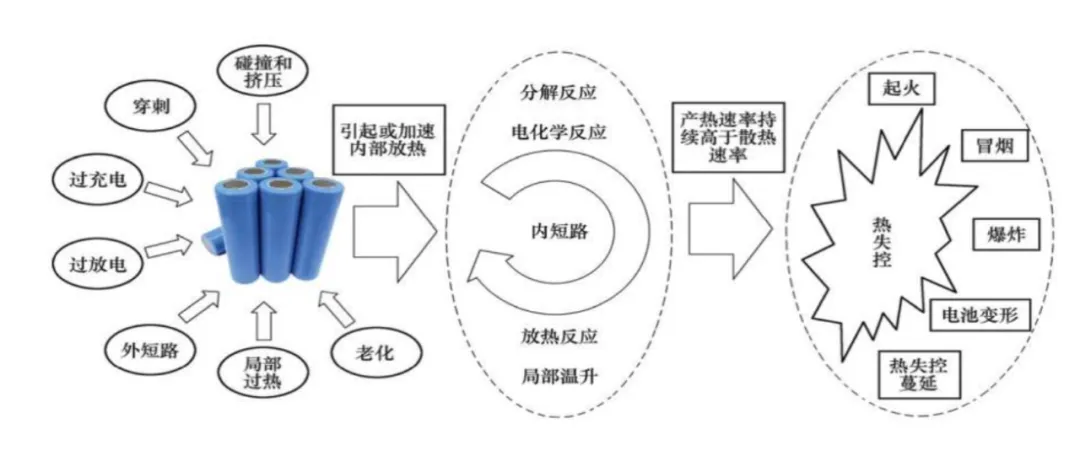
Figure: Lithium-ion power battery internal short circuit under certain conditions, which triggers thermal runaway
Data source: Review of thermal runaway and safety management of lithium-ion power batteries
The composite current collector can inhibit the growth of lithium dendrites, and the burr size generated during puncture is small, which can effectively avoid internal short circuit. The polymer flexible substrate in the composite current collector has good flexibility and ductility, can absorb part of the stress, and is not easy to break; at the same time, the compressive stress generated during the deposition of lithium metal can be released, thereby effectively controlling the generation of dendrites and preventing puncture from causing internal short circuits. Even if it is punctured, the burr size generated by the 1 μm copper plating layer of the composite current collector material is small, which is not enough to puncture the diaphragm, and the internal short circuit can be effectively avoided.
The thermal short circuit effect of the composite current collector can control the thermal runaway of the battery. Composite current collectors have traditional techniques such as adding flame retardants to the electrolyte, which can only delay internal short circuits at the expense of battery energy density. However, the polymer substrate in the middle of the composite current collector has flame retardant characteristics, and its metal conductive layer is thin. When short-circuited, it will fuse like a fuse and melt quickly before thermal runaway. The battery damage is limited to the puncture site to form a "point open circuit".
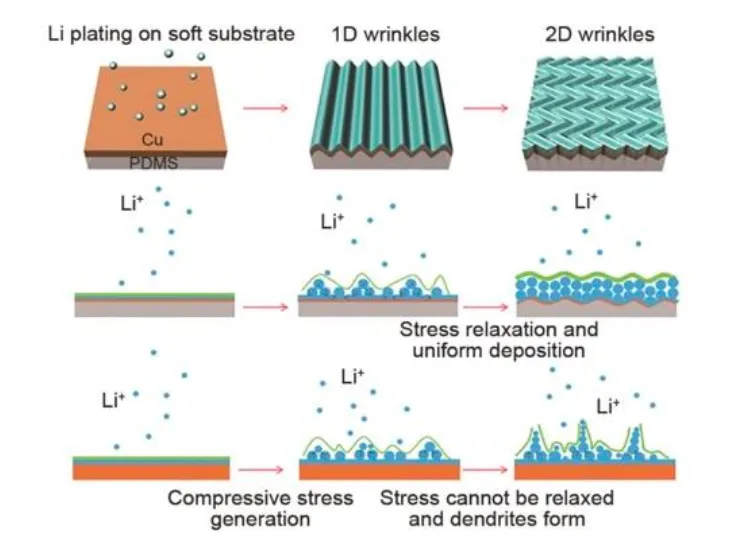
Flexible current collector slows down lithium dendrite growth
Data source: Nature Energy
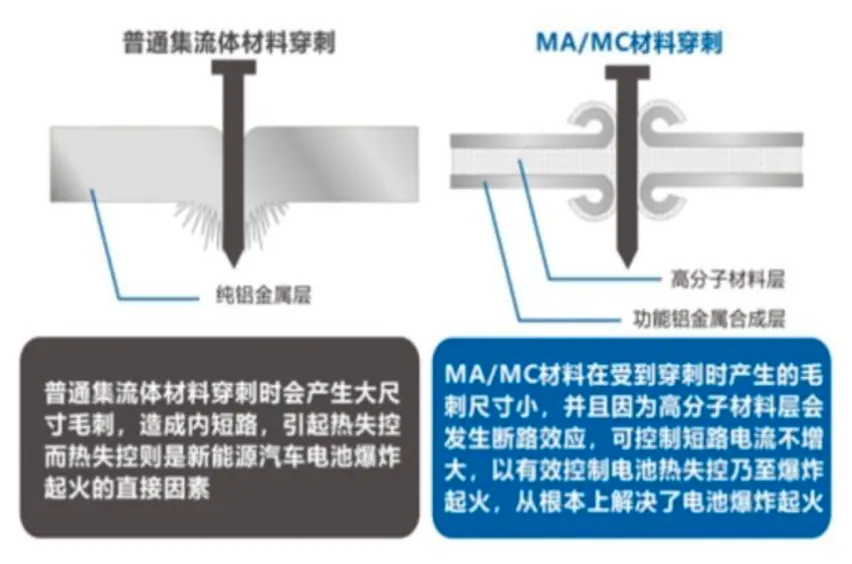
Thermal Short Circuit Effect of Composite Current Collector to Prevent Thermal Runaway
Data source: Jinmei New Materials Technology official website
3, lightweight effectively improve the energy density of lithium batteries
The intermediate layer of the composite current collector adopts a lightweight polymer material to achieve the goal of lightening and thinning, thereby increasing the energy density of the lithium battery. Since the density of the alternative material PET/PP is much lower than that of copper foil, the weight of PET/PP copper foil can be reduced by 56%/60% compared with that of traditional copper foil under the same thickness. Moreover, the density of copper foil in the current collector is much larger than that of aluminum foil, so reducing the thickness of copper foil can effectively realize the weight reduction target of the battery, effectively improve its mass energy density, thus increasing the filling amount of active substances in the battery, and further. Through the experiment, by applying different auxiliary materials to reduce the thickness of the copper foil, the energy density gain of the battery is obvious.
The intermediate layer of the composite current collector adopts a lightweight polymer material to achieve the goal of lightening and thinning, thereby increasing the energy density of the lithium battery. Since the density of the alternative material PET/PP is much lower than that of copper foil, the weight of PET/PP copper foil can be reduced by 56%/60% compared with that of traditional copper foil under the same thickness. Moreover, the density of copper foil in the current collector is much larger than that of aluminum foil, so reducing the thickness of copper foil can effectively realize the weight reduction target of the battery, effectively improve its mass energy density, thus increasing the filling amount of active substances in the battery, and further. Through the experiment, by applying different auxiliary materials to reduce the thickness of the copper foil, the energy density gain of the battery is obvious.
It is estimated that PET/PP copper foil reduces weight by 56%/60% compared with traditional copper foil, and PET aluminum foil reduces weight by about 41%. According to the copper density of 8.96g/cm3, aluminum density of 2.7g/cm3,PET density of 1.37g/cm3 and PP density of 0.9g/cm3, we assume that the positive and negative electrodes required for a single GWh lithium ion battery are both 12 million square meters, which can be calculated to reduce the weight of 6μm PET copper foil by 56%,6μm PP copper foil by 60% and 12μm PET aluminum foil by 41%.

Table: PET/PP copper foil reduces weight by 56%/60% compared with traditional copper foil, and PET aluminum foil reduces weight by about 41%
4, Compared with traditional copper foil, the scale cost of composite copper foil is significantly reduced by 41%.
Copper foil accounts for about 8% of the total cost of lithium batteries, second only to positive, negative and separator, composite current collector reduces the amount of metal foil, thereby reducing the cost of raw materials. Taking composite copper foil as an example, the material price of traditional lithium-electric copper foil is much higher than that of PET (or PP) material. It is estimated that the unit area cost of the raw material of 6μm composite copper foil under the same thickness is 1.30 yuan/m2, which is 65% lower than the traditional copper foil raw material of 3.74 yuan.

Cost reduction of (1+4+1)μm composite copper foil and electrolytic copper foil by more than 20%
Data source: 2023 High-level Lithium Materials Conference

Manufacturing Cost of Composite Copper Foil About 3.1 ¥/m2
Data source: 2023 High-level Lithium Materials Conference
Preparation method of 2. composite current collector
Existing processes in the (I) market include "one-step", "two-step", "three-step"
At present, the two-step method (magnetron sputtering water plating) is widely used in the market, and it is preliminarily proved that the two-step method can achieve large-scale mass production. The one-step method is expected to produce samples in the second half of the year, with a verification cycle of 6-9 months, and the timing of mass production is uncertain.
1. Two-step method
1.1 for magnetron sputtering, the advantage is that the bonding force of the film and the substrate is very strong, the disadvantage is that the growth rate of the film is slow, high-energy particles may damage the base film, there is a certain degree of difficulty in the process. The difficulty lies in how to protect the base film from breakdown and wrinkle because the substrate is relatively thin and the ability to withstand high temperatures is limited.
Compared with magnetron sputtering, 1.2 water plating has the advantages of faster growth rate and milder growth temperature environment. The disadvantage is that the current is uneven, so the edge effect may cause local perforation. The difficulty is that the base material is extremely thin and repeatedly passes through the roller. How to protect the base film from breakdown and wrinkle.
2. One-step method
2.1 dry process
That is, the process of forming a composite current collector by completing copper and aluminum plating on the PP/PET base film at one time, mainly by magnetron sputtering/double-sided electron beam evaporation.
2.2 electroless plating
Similar to the silver mirror reaction in chemistry, no electrical energy is required to plate the film on it but through a chemical catalytic reaction. However, there are also corresponding problems, such as the tolerance of strong acids and alkalis, and the cost control of some catalysts using precious metals, which need to be solved.
3. Three-step method
Including magnetron sputtering plating vacuum evaporation.

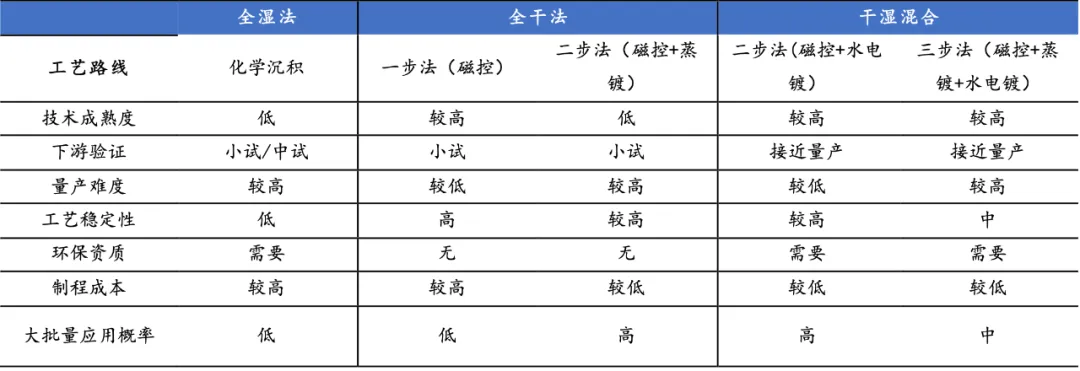
Several Preparation Methods of Composite Copper Foil on the Market
(II) mainstream processes include magnetron sputtering, vacuum evaporation, electroplating, electroless plating
1. Vacuum evaporation equipment
The principle is to evaporate or sublimate the metal to be deposited by heating, and the particles are deposited on the substrate. The overall film forming speed is faster and the cost is lower, but the interface bonding ability is slightly lower, and the base film is easy to deform.
2. Magnetron sputtering equipment
The principle of magnetron sputtering is to slam the target material under the action of rare gas argon in a magnetic field, and then sputter to the base film to form a thin film. The binding force of magnetron sputtering is generally good, and the technical difficulty of the equipment also leads to higher cost and lower coating efficiency.
3. Electroplating equipment
Electroplating is a metal electrodeposition process that includes liquid phase mass transfer, electrochemical reaction, and electrocrystallization. The principle is that metal ions are reduced under the action of an external electric field and deposited on the cathode.
4. Electroless plating equipment
The principle is to deposit metal copper on the surface of polymer materials by self-catalytic redox reaction method. Using the reducibility of formaldehyde in a strong alkaline environment, and under the catalytic action of Pd, copper ions are reduced to copper. Electroless copper plating is a mature process, which is widely used in PCB and other industries.
Overview of 3. Industrialization
Active layout of all links of the (I) industry chain, industrialization progress gradually accelerated
The composite collector has now achieved a 0-1 breakthrough, the industrial chain is actively laying out all links, the industrialization progress growth rate is obvious.
Among them, the progress of composite aluminum foil is faster, the leading manufacturer Jinmei new material has announced in November 2022 to take the lead in realizing the mass production of 8 m composite aluminum foil, composite copper foil is still in the technical research and development and trial verification period, but the recent catalytic factors intensive, industrialization certainty is strong, will enter the first year of large-scale mass production.
From the industrial chain point of view, the upstream mainly includes raw materials and equipment suppliers, the midstream is the composite collector manufacturing link, the downstream is the lithium battery application end.
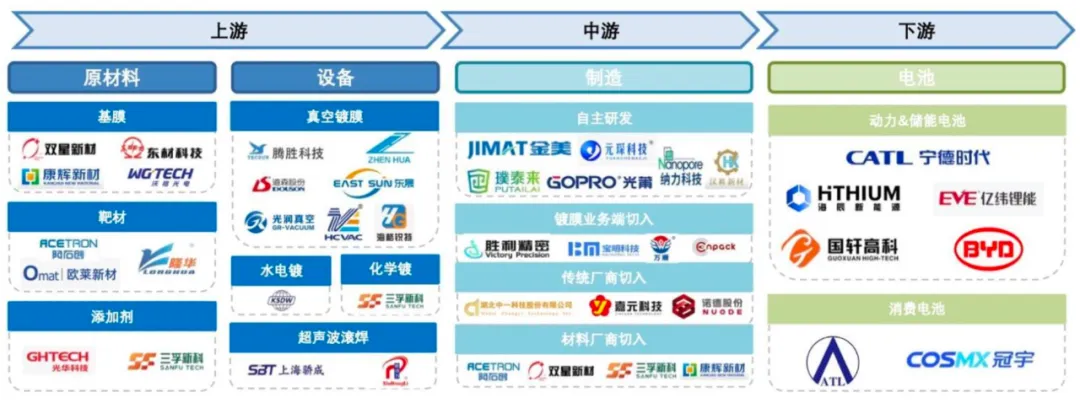
Figure: Active layout of all links in the composite collector industry chain
Data source: company announcements
1. Upstream suppliers of raw materials and equipment
1.1 basal membrane end
There is a PP/PET/PI dispute in the industry, the three substrates have their own advantages, and the application scenarios are different, due to the high cost of PI base film, the future or the emergence of PP/PET both coexist in the market pattern. Both products have accelerated in recent iterations-the industrialization of PET base film is progressing faster and is currently the mainstream route in the industry. Domestic major PET manufacturers double star new material, Kanghui new material have mass production capacity, and the recent downstream verification of high temperature cycle test results have significantly improved. The progress of PP base film has made a great breakthrough compared with the previous one. Baoming Technology has broken through PP copper foil technology and has now realized mass production and sent samples to battery factories for testing. Wanshun New Material and Shengli Precision followed closely and continued to push forward. Its progress is the focus of the manufacturing process.
1.2 other auxiliary materials
In terms of target materials, the domestic market share continues to increase, Ashtron and other enterprises lead. The global market was previously monopolized by Japanese and American enterprises, with high industrial concentration and low market share of domestic enterprises.
In recent years, domestic manufacturers have entered the bureau, rapid development, and constantly break through key technical barriers, and expand production capacity, domestic substitution process accelerated. The domestic leading manufacturers that can supply composite collector copper targets are mainly Ashtron, Jiangfeng Electronics and research new materials. In terms of electroplating chemicals, Guanghua Technology mainly supplies water electroplating links, Sanfu Xinke mainly supplies chemical plating links. Guanghua Technology mainly supplies electroplating solution for the water plating process of PVD process, which is one of the few suppliers in the field of PET composite copper foil that can provide a full range of chemical solutions, including copper sulfate solution, copper oxide and so on. Sanfu Xinke mainly distributes chemical copper plating solution, cooperates with special chemicals for composite copper foil to carry out one-step all-wet composite copper foil plating equipment business, provides special supporting production equipment, and provides downstream customers with one-stop technical solutions for composite copper foil manufacturing through "liquid medicine equipment". The company also supplies plating additives for copper plating.
1.3 equipment end
Composite copper foil core equipment continues to iterate, and gradually realize domestic substitution. Domestic magnetron sputtering, water plating and ultrasonic roll welding equipment due to low cost, after-sales service and maintenance convenience, short production cycle and other comprehensive advantages gradually realize domestic substitution, the current industry concentration is high. Among them, the front magnetron sputtering equipment Tengsheng Technology leads the way, and Huicheng Vacuum, Zhenhua Technology, Haigerite, etc. have also realized mass production. The equipment of Dongwei Technology in the back water plating is in the leading position in the world, and only Dongwei has the capacity of large-scale mass production in China. The pole ear welding equipment at the battery end, the leading manufacturer, is proud of the ultrasonic breakthrough core technology, deeply bound with Ningde era, and is in a monopoly in the short term.
The vacuum evaporation equipment to be used in the three-step method of composite aluminum foil and composite copper foil is still mainly dependent on the equipment imported from Japan's Fanaco, which is more expensive. In addition, Tengsheng Technology's magnetron sputtering all-in-one machine and Sanfu Xinke's all-wet chemical copper plating equipment have been shipped, one-step product testing results are good, the future industry's final technical route has not yet been determined.

Figure: Composite Copper Foil Equipment Gradually Realize Domestic Substitution
Data source: company announcements
2, midstream for the composite collector manufacturing end, the industry's new and old manufacturers have entered the bureau.
2.1 composite collector manufacturing end, the start-up signal is obvious, the industry's new and old manufacturers have layout, forming a hundred flowers bloom situation.
The main layout of the manufacturers can be divided into four categories: the material manufacturers cut in and the coating business end cut in, through the accumulation of homologous technology to extend to the composite copper foil, such as Ashichuang, Double Star New Material and Baoming Technology, Shengli Precision; Independent research and development, such as Chongqing Jinmei, Yuanchen Technology, Nali Technology and other deep-cultivated composite collector research and development; Traditional manufacturers cut in, such as Zhongyi Technology, Jiayuan Technology, Jiayuan Technology, take advantage of existing process technology and production experience to transform your business.
The 2.2 industry has an accelerated trend, with an increase in the number of new manufacturers, and head manufacturers taking the lead in expanding production and promoting mass production. Composite copper foil is progressing well and mass production is imminent.
Head manufacturers such as Jinmei, Baoming progress faster, has achieved small batch production, loading tests, other manufacturers such as Yangzhou Nili, Shengli Precision, Wanshun New Material, Double Star New Material and other early layout manufacturers have also actively sent samples to the downstream test. Among them, the composite copper foil products of Double Star New Material and Wanshun New Material have been repeatedly tested and verified by customers, and obtained the first order, which is a breakthrough in the field of composite current collector. Major manufacturers have announced plans to expand production. Jinmei has taken the lead in planning 1.2 billion square meters of production capacity, Baoming has planned nearly 4 billion square meters of production capacity, and British Union, Shengli Precision and Yuanchen Technology have also planned 5-1.2 billion square meters of production capacity. Recently, the industry's catalytic factors are frequent, industrialization certainty is strong, attracting new manufacturers Sdick into the bureau, it has announced plans to build composite materials expansion projects, is still in the stage of technology research and development.
3. Positive sample of downstream battery factory
Downstream battery plants in 3.1 are actively testing and verifying samples to promote the industrialization of composite current collectors.
The composite copper foil needs to go through four rounds of tests before application. The first is the physical property test to test the basic physical properties such as square resistance, bonding force and tensile strength for a week or so. The second step is to test the processing performance of the application battery, about a month or so. Then the most critical cycle performance test will take 6-7 months. Finally, the loading road test will be carried out. From the sample test results, PET copper foil has recently undergone a second round of high temperature cycle tests, and the results are significantly better than the first round, but it does not meet the ideal requirements of the battery factory-more than 2500 times at normal temperature and more than 1800 times at high temperature. In terms of PP copper foil, Baoming Technology has made a significant breakthrough, and the results of the physical property test are good, completing all the test links.
The terminal application advantages of 3.2 composite collector are obvious, and the commercialization is strong.
On March 30, 2023, Ean held a press conference on the 2.0 shooting test of magazine batteries. For the first time in the world, the whole pack of batteries did not catch fire, and once again defined a new standard for battery safety. The magazine battery is 2.0 at the level of the battery core material, and innovatively introduces and applies a composite current collector, specifically the composite aluminum foil supplied by Jinmei, which can provide a large resistance through fusing and insulating materials when the battery is short-circuited, and cut off or reduce the short-circuit current in a short time, thus greatly avoiding the hidden danger of fire. The magazine battery 2.0 will first be carried on the hyper of the Eian luxury super-running brand.
On March 30, 2023, Tianneng Battery released a new generation of manganese-iron lithium battery TP-MAX for two-wheeled vehicles, also with the application of composite current collectors as the highlight of safety upgrades. On June 1, 2023, Ningde Times announced that Kirin battery had been loaded with krypton 001, and Kirin battery NP2.0 also used Chongqing Jinmei composite aluminum foil. The composite collector fully demonstrates its core advantages of safety at the battery end, and the acceleration of loading progress further confirms the commercial landing, showing its wide range of terminal applications. At present, due to the comparative advantages of mature process and strong safety, the industrialization of composite aluminum foil is progressing rapidly, and it is expected to take the lead in realizing large-scale application; composite copper foil is further optimizing the process and promoting mass production. Both have their own advantages, or apply to the same segmentation scenario, but the prospects for industrialization are certain.

Figure: Magazine battery 2.0 application of composite current collector, safety enhancement
Data source: Car Home
(II) composite copper foil market space has great potential, 2025 or over 15 billion
The 1.1 composite copper foil market space has great potential, and the market size can reach 16.8 billion billion yuan in 2025.
With the maturity of composite copper foil technology, 2023 is expected to become the first year of mass production application of composite copper foil. With the increase in the permeability of composite copper foil, composite copper foil shipments are expected to reach a new level by 2025, entering a period of real replacement of traditional copper foil. Assuming that the penetration rate of composite copper foil in the global lithium battery field is 2%, 5% and 12%, respectively, from 2023 to 2025, the average selling price of composite copper foil is 6.2 yuan/m2, 5.9 yuan/m2 and 5.6 yuan/m2, respectively. It is estimated that the shipment volume of composite copper foil is expected to reach 3 billion square meters by 2025, corresponding to a market size of about 16.8 billion yuan.
1.2 equipment is the first to benefit, and the market size is expected to reach 14.3 billion yuan in 2025.
According to GGII forecasts, lithium battery shipments from 2023 to 2025 are 1119/1416/1805GWh respectively. As the permeability of PET composite copper foil is currently low, but downstream membrane manufacturers, electrolytic copper foil suppliers are actively layout composite copper foil production capacity or has been in the product delivery stage, so the later permeability will continue to improve. According to this, assume that the permeability of composite copper foil from 2023 to 2025 is 2%, 5% and 12%; assume that the value of water plating equipment is about 12 million/unit, and the unit price of magnetron sputtering equipment is 15 million yuan/unit; assume that 1GWh battery needs 3 water plating equipment and 2 magnetron sputtering equipment. If the process is all two-step, after the above assumptions, the market size of composite copper foil equipment is expected to reach 14.3 billion yuan in 2025.
The (III) composite collector material end is facing controversy, and the industrialization process is continuing.
1. The selection of basement membrane is inconclusive, and PP basement membrane is expected to dominate in the long run.
Since the two substrates may be suitable for different types of lithium batteries, the choice of PP/PET is still inconclusive, and the PP base film is expected to dominate in the long run.
1.1 PP base film
The number of charge and discharge cycles of the battery will be more, and the life of the composite copper foil battery using PP as the substrate is longer than that of the PET substrate composite copper foil battery. For battery manufacturers, the performance of the PP substrate in the experimental link is more satisfactory. However, compared with PET,PP film material has low hardness, is not easy to process, and the early yield is very low. At the same time, the initial stage of all aspects of the process is not perfect, easy in the magnetron sputtering link through the PP base film. Since PP does not contain ester bonds in the molecule, it has better acid and alkali resistance than PET.
1.2 PET basement membrane
Better processing, higher yield, lower overall cost. For composite copper foil manufacturers, mass production of PET copper foil, cost, yield, consistency are better than PP copper foil.
1.3 PI basement membrane
The density is similar to PET, but the melting point and use temperature are the highest, and the overall stability and mechanical properties are the best. However, the cost is high and there is no market potential at present.
It is believed that for equipment manufacturers, the two materials can use the same equipment (only need to adjust the parameters), because the future trend mainly depends on the technical iteration speed of PP and PET base film products. In the future, if the PP substrate process is improved in all aspects, the processing cost and rate can be leveled with PET, PP will have more advantages; on the other hand, if the PET substrate product is continuously modified to extend the battery life to be similar to the PP substrate, PET will have more advantages.
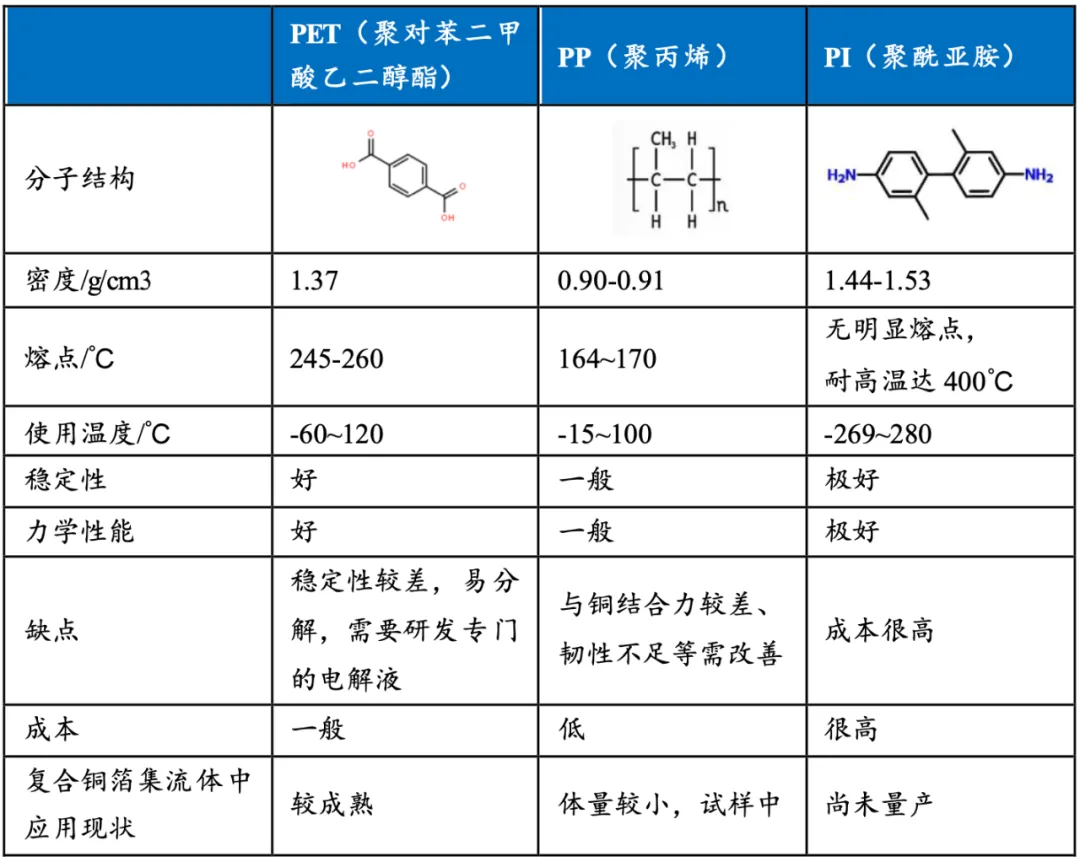
Comparative Analysis of Three Base Film Materials, PP Base Film Has More Scale Potential
Data source: 2023 High-level Lithium Materials Conference
2, composite copper foil and composite aluminum foil to take different preparation scheme, that the composite copper foil application space is broader.
The potential of the positive and negative electrodes of the lithium ion battery determines the aluminum foil for the positive electrode and the copper foil for the negative electrode. The positive electrode potential is high, the copper foil oxide layer is loose, and it is easy to be oxidized at high potential, while the oxidation potential of aluminum is high, and the surface of aluminum foil has a dense oxide film, which also has a good protective effect on the internal aluminum. Aluminum will undergo alloying reaction with lithium at low potential and be consumed. Due to the high activity of the reaction between metal aluminum and lithium, metal aluminum consumes a large amount of lithium, the structure and shape of itself are also destroyed, so it can not be used as the current collector of the negative electrode of the lithium ion battery; copper has only a small amount of lithium insertion capacity during the charging and discharging process of the battery, and maintains the stability of the structure and electrochemical performance, which can be used as the current collector of the negative electrode of the lithium ion battery.
In the preparation scheme, the composite aluminum foil is relatively simple, and the evaporation method is the main method; the preparation method of the composite copper foil is still uncertain. Due to the poor binding force of PP and copper, it is considered that the industrialization possibility of PET composite aluminum foil and PP composite copper foil is higher.
It is judged that by 2025, the products shipped may be mainly composite aluminum foil, supplemented by composite copper foil. According to the industry chain research, the current composite aluminum foil has been mass production, and the composite copper foil is still in the sample or small batch stage. Since the cost advantage and process advantage of composite collector is not very superior to traditional collector before 2025, we estimate that the composite collector penetration rate of China's collector industry will not exceed 10% by 2025, and the main application market will be more concentrated in high-end, high safety requirements.
In the long run, the application space of composite copper foil is far more than that of composite aluminum foil. In the short term, the application market of composite copper foil and composite aluminum foil is mutually exclusive, mainly because whether the battery positive or negative electrode uses composite current collector can meet the battery factory's demand for high energy density and high safety, only composite copper foil/aluminum foil replacement can meet the requirements. However, the cost effect of composite aluminum foil is far less than that of composite copper foil, and composite copper foil has more advantages for the improvement of energy density. Under the existing process conditions, the large-scale replacement power of composite copper foil is much greater than that of composite aluminum foil in the long run.
3. There are still bottlenecks in the industrialization of composite current collectors.
It is believed that the core focus of the current technical bottleneck is in three aspects:
3.1 technology end
At present, the composite copper foil does not have good safety compared with the traditional very thin layer in terms of heat accumulation and conductivity. On the contrary, due to the thinning of the copper foil, the internal resistance of the battery increases, which makes the temperature rise in the battery more serious, and the sandwich structure also causes the internal heat conduction of the battery to be limited, which affects the conductive efficiency.
3.2 cost end
High-end base film has import dependence, industrialization pre-equipment costs are higher, resulting in higher production costs than the cost of traditional copper foil, is expected to reduce the rate of more than a certain level (mass production costs below 3 yuan) will achieve industrialization.
3.3 equipment and process end
How to better realize the combination between metal and polymer atoms and overcome the problems in the production process to improve the yield.


Table: Bottlenecks still exist in the industrialization of composite current collectors
Data source: 2023 High-level Lithium Materials Conference
In the early stage of (IV) industrialization, upstream and downstream manufacturers jointly promote and actively layout
1, upstream and downstream manufacturers actively layout, progress smoothly
At present, in the equipment company first release stage, the industry business climate continues to improve. Equipment manufacturers in the GW capacity of equipment companies have been added, but also a lot of new material manufacturers new capacity. At present, the composite collector for the early stage of permeability improvement, in the industrialization trend is more certain, listed companies Double Star, Wanshun 23 in the first half of the announcement of the first order, downstream battery factory from 23 years of the first order landing 0-1 breakthrough, the end of 2023 will determine the mass production process route, 2024 began to get on the bus.
2, the future trend of industrialization focus on technological breakthroughs and material delivery sample testing progress.
Industrialization mainly focuses on the following three aspects: 1) The material end pays attention to the progress of material sample delivery test. It is estimated that the physical property test of samples delivered by some battery factories has passed, and the circulation test results in December and the boarding progress in the first half of 2024 need to be continuously tracked; 2) The equipment end pays attention to the landing of ultrasonic pole ear welding orders. The ultrasonic pole ear welding equipment is the only deterministic process link in the process flow. The order landing mark terminal battery factory has been completed batch boarding plan. 3) At the technical level, breakthroughs in the base film and technical bottlenecks, such as the addition of flame retardants and other improved mechanisms, have made breakthroughs.
4. investment advice
It is believed that the progress of the industrialization of composite collector is less than expected, the capital expenditure of downstream battery plants is limited, the industrialization process continues to be delayed, and it is believed that the recent industry catalysis is frequent, and the progress of the industry landing in 2025-2026 is optimistic.
1. In October 2023, Yan Tailai and Ningde signed a strategic cooperation agreement on the composite copper foil collection fluid business.
2. The composite current collector will be applied to the Selis M9 model listed in December 2023. Chongqing Jinmei New Material will supply the composite current collector for it. It is another case of the composite current collector getting on the bus in China after geek 009, the first model of global mass production of Ningde Times Kirin Battery in April 203 this year, used the composite current collector.
It is believed that safety weight reduction is the core competitiveness of the composite collector, the early stage is expected to be applied to high-end models or export safety requirements of higher European countries, the first half of 2024 composite collector to achieve the car.
Actively pay attention to the investment opportunities of non-listed companies Jinmei new material, Nili new material, Shuhong equipment incubation of benzene ring new material.
(Source: Rui Zhengfu Investment)
recommend News
Shantou Best participates in the Polish International Plastics and Rubber Processing Fair
Shantou Best will present masterbatch solutions and technology upgrades at the PLASTPOL (21-24.05.2024) /28th International Plastics and Rubber Processing Expo.
Collection! Composite current collector industry research report
The function of the current collector is to carry the active material. During the charging and discharging process, the current generated by the current collector is collected and output or the current is input to the active material as a medium to realize the conversion of chemical energy and electrical energy.
Shantou Best Annual Party 2024 successfully held.
Shantou Best Annual Conference was successfully held last Thursday. During the gala, we honored outstanding staff and departments.


